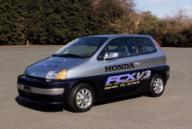New Honda-Designed Fuel Cell Added To California Fuel Cell
Vehicle Demonstration Program
TORRANCE, Calif., Feb. 13 A Honda FCX-V3 fuel cell vehicle
equipped with a new Honda-designed fuel cell stack, has joined the fleet of
vehicles participating in the California Fuel Cell Partnership's (CaFCP)
public highway demonstration program, Honda Motor Co., Ltd., announced today.
Earlier Honda FCX versions were powered by fuel cell stacks developed by
Ballard Power Systems, Inc., including the FCX-V1 introduced in 1999 and a
previous version of the FCX-V3 that has been participating in the CaFCP
program since it started last November. The FCX-V2 was powered by the first
generation Honda stack and demonstrated in September 1999.
The new version of the FCX-V3 reflects the improved performance and
reliability of Honda's own fuel cell stack design. The CaFCP program will
help verify the on-road performance of Honda's fuel cell technology.
The Honda fuel cell stack stores gaseous hydrogen under high pressure to
create electricity, which in turn drives an electric motor and the wheels.
Combined with a Honda-developed ultra capacitor, it provides excellent
response and high efficiency. Environmental performance is also outstanding
with zero emissions, zero C02 and the potential to use renewable fuel.
"Honda believes the fuel cell offers tremendous potential as a high
efficiency automotive powerplant," said Ben Knight, vice president of Honda
Research and Development and the company's CaFCP representative. "We will
continue to pursue fuel cell vehicle development with stacks of Honda's own
design and others."
The FCX-V3 seats up to four persons and features a startup time of about
10 seconds (compared to a 10-minute startup time of some previous models).
Vehicle operation is also very quiet. The ultra-capacitor contributes to
acceleration performance as well as highly efficient energy management.
The CaFCP is based in West Sacramento and is a joint-participation project
that includes the California and Federal government agencies, energy
companies, auto manufacturers and fuel cell stack manufacturers. The
objective of the project is to work cooperatively to lay a foundation for
future fuel cell commercialization. This includes the advancement of fuel
cell vehicles, the development of fueling and infrastructure approaches, and
expanding public awareness of the benefits of fuel cell technology.
FCX-V3 with Honda FC Stack: System Layout (Conceptual)
Air Supply System
|
|
|
|
\|/
Humidification
Drive Motor < --- Fuel Cell Stack High-Pressure
developed by Hydrogen
Honda ----- Humidification ---- Tank
/\
|
|
\/ /\
|
|
Ultra- Cooling
Capacitator System
FCX-V3 with Honda FC Stack: Specifications
Maximum Speed 130km/h
Vehicle Weight 1,750kg
Motor Maximum Power Output 60kW
Maximum Torque 238Nm
Motor Type Permanent magnet AC
synchronous
Fuel Cell Stack Stack Type PEFC (Polymer Electrolyte Fuel
Cell - developed by Honda)
Power Output 70kW
Fuel Fuel Type Pure hydrogen
Storage Method High-pressure hydrogen storage
tank (250 atmospheres)
Fuel Capacity 100 liters



